 |
Fortaleza de São João Baptista do Monte Brasil
Angra do Heroismo, Terciera, Azores
|
|
 |
Constructed: 1593-1639
Used by: Spain, Portugal
Conflict in which it participated:
Portuguese Restoration
Also known as:
Military Building 001 / Angra do Heroismo
Fortaleza de São Filipe
Mount Fortress Brazil
|
I know what you're thinking: The word Brasil, a ridiculously long bombastic name, this fort must have been built by the Portuguese, right? You are so wrong, my friend!
The Azores Islands, about 930 miles west of Lisbon, were indeed discovered by the Portuguese, in 1431. |
 |
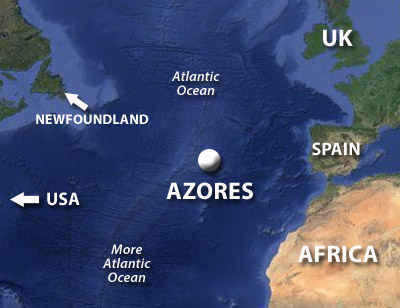 |
|
The Portuguese were also the ones who colonized these islands a few years later (sheep were released on the island before colonization so the colonists would have something to dominate once they got there), but Spain's King Phillip II (1527-1598) swept into Portugal in 1580, claiming the throne for himself due to a rather murky succession issue - and suddenly everything Portuguese was Spanish, including Portugal's many overseas holdings.
|
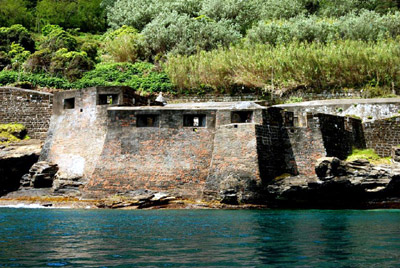 The Fortaleza's western bastion, what one would see were one attacking from the water: Not much to grab onto! |
 |
Phillip ordered the construction of a major fortification on the island of Terciera (literally "third") shortly after nabbing it from the Portuguese, in the interest of protecting both the archipelago and fleets of Spanish ships sailing from the New World with untold treasures, from pirates, Corsairs and "heretics" (the English, French and Dutch)...and also as a cool place for Spanish troops to hang out as they oversaw the subjugation of the Azores.
The fort was naturally originally named Fortaleza de São Filipe, since it wouldn't do to build something and then not name it after the King.
|
|
|
Work began in 1593. The fort was built, mostly with forced labor from the local populace, on a promontory that connects the island of Terciera with the volcanic crater of Monte Brasil, watching over the Bay of Angra. It held a garrison of 1500 men and mounted 400 pieces of artillery of various sizes. It became one of several "most important Spanish fortifications in the Atlantic," possibly the largest such fortification ever built by Spain, but it wasn't destined to be Spanish for long.
|
The Azores were returned to Portuguese control in 1642, two years after Lisbon threw off the Spanish yoke of oppression. Local inhabitants and Portuguese troops besieged the Spanish garrison at the fort from March 27, 1641 to March 4, 1642, at which time the Spanish surrendered and were allowed to return to Spain unmolested. The Spanish left copious amounts of ammunition, cannon and muskets behind, and the fort was renamed São Jão de Baptista.
Portuguese King Afonso VI (1643-1683) was impotent. When the Queen, Marie Françoise Elisabeth de Savoie (1646-1683), discovered this disturbing fact upon their marriage, she filed for an annulment in 1667 and married the King's brother Pedro.
|
 |
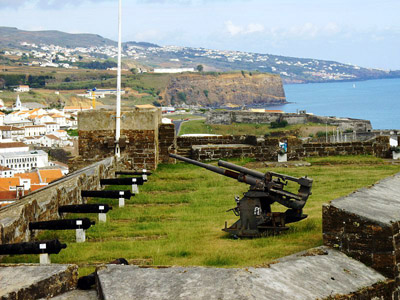 Lots of guns are on display today at the Fortaleza, including at least one antiaircraft gun of a WW2-ish vintage. Lots of guns are on display today at the Fortaleza, including at least one antiaircraft gun of a WW2-ish vintage. |
|
Pedro would go on to become King Peter II (1648-1706), and Afonso was forced to abdicate his throne on June 22, 1667. The Impotent One found himself exiled in the Fortaleza of our current interest from 1669 to 1674. The palace of the Governor was located within the walls of the Castelo, which made for a comfy exile pad. Kind of harsh punishment for a dude just because he can't get it up, but then this is the aristocracy we're talking about...and if they can't get it up, what hope is there for the rest of us?
|
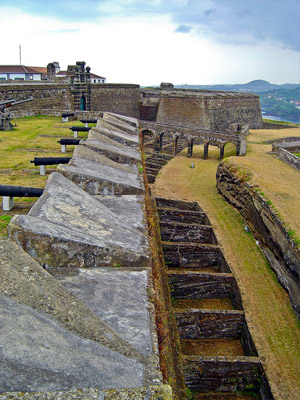 The Fortaleza's northern curtain wall. The adorable bridge that you can barely see leads to the main gate. |
 |
A series of struggles took place in Portugal from the early 1820's through the Portuguese Civil War (1828-1834), having to do with the form of government under which Portugal would operate: The first time the blue and white flag of Portugal's constitutional monarchy flew was over the Fortaleza de São João Baptista do Monte Brasil on June 22, 1828. The flag had been sent to the Azores by Portugal's Queen Maria II (1819-1853) expressly for this purpose.
A mint was built in the fort in 1829, making Portuguese coinage for the first time in the islands, as opposed to importing it from Portugal.
Portugal had a strongish alliance with Great Britain due to the latter's efforts on the former's behalf during the Napoleonic Wars (1803-1815). This alliance lasted into the 20th century: German citizens who had been unfortunate enough to have been in Portugal at the outset of the First World War (1914-1918) were sent to the Azores to be imprisoned at the Fortaleza de São João Baptista do Monte Brasil until a "determination" could be made as to their status. Perhaps they're still there.
|
|
|
The Estado Novo was proclaimed in Portugal in 1933. This was essentially an authoritarian dictatorship led by António de Oliveira Salazar (1889-1970), who made use of the Fortaleza as a military prison, handy for holding those who weren't down with the whole authoritarian dictatorship thing for whatever reason.
Though Portugal was one of only five European nations to remain neutral during the Second World War (1939-1945), Salazar leased bases in the Azores to Great Britain, allowing the Allies to provide air cover to its navies as they steamed across the Atlantic. The US Navy built an airfield on Terciera in 1945, which was used through the Cold War for antisubmarine patrols, snooping for Soviet subs.
|
In 1976 the Azores became an Autonomous Region, but the Portuguese military still garrisons the Fortaleza de São João Baptista do Monte Brasil, the oldest operating Portuguese military base with an uninterrupted stay of over 400 years (if you don't count that pesky Spanish period in the 16th and 17th centuries, but one suspects that that era is still considered a pseudo-Portuguese one), and is Portugal's westernmost military outpost. Much of the fort is open to the public on a daily basis.
|
 |
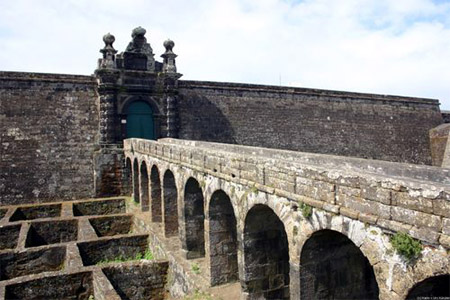 The Fortaleza's main gate. The Fortaleza's main gate. |
|
|
|
|
|
|
 |




